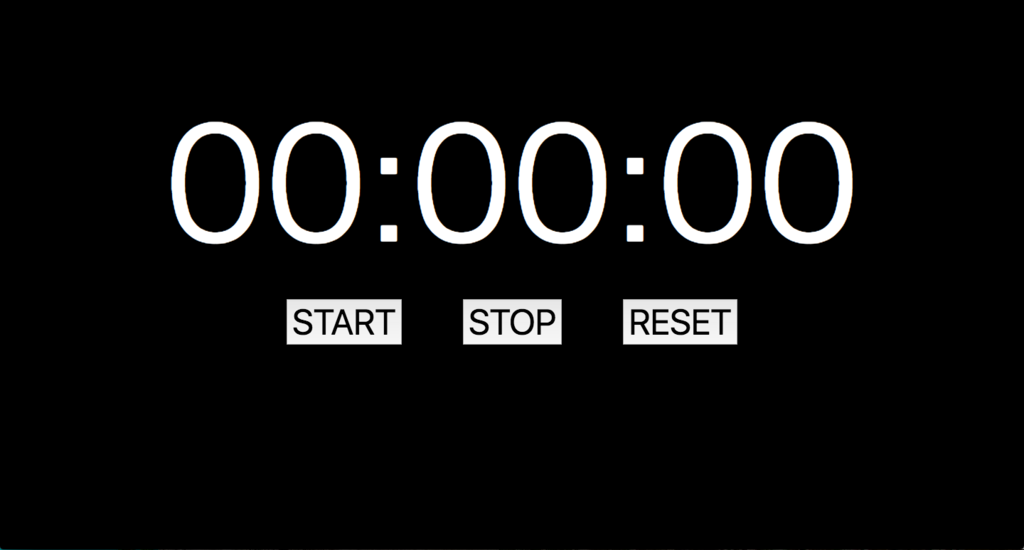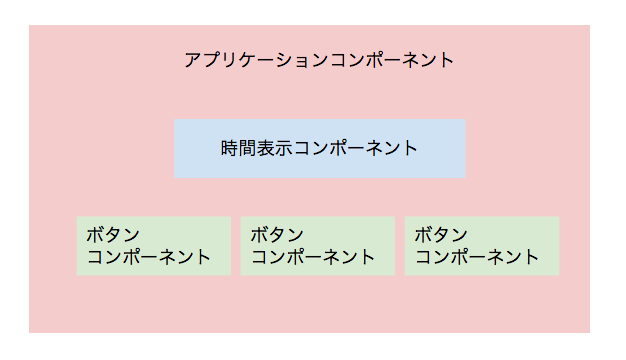はじめに
この記事はHamee Advent Calendar 2016の8日目の記事です。
最近、Reactが熱いですね!
今回は、前から気になっていたReactと相性が良いと言われるfluxフレームワークのReduxを使って、カウントアップタイマーを作ってみようと思います。
開発環境の構築
ビルドツールとしてwebpackを使っていきます。
またES6とReactのJSXは、webpackのbabel-loaderでコンパイルします。
$ npm i --save-dev webpack babel-core babel-loader babel-preset-es2015 babel-preset-react
webpackの設定をwebpack.config.jsに記述していきます。
module.exports = {
entry: './js/main.js',
output: {
path: 'dist',
filename: 'bundle.js'
},
module: {
loaders: [
{
test: /\.js$/,
exclude: /node_modules/,
loader: 'babel-loader',
query: {
presets: ['es2015', 'react']
}
}
]
}
}
続いて、react, reduxのインストールです。
$ npm i --save react react-dom redux react-redux
インストールしたライブラリの概要は以下の通りです。
react, react-dom: Reactのライブラリ
redux: Fluxフレームワーク
react-redux: ReactとReduxを連携させるためのライブラリ
packge.jsonのタスクコマンドにwebpackのbuildとwatchを追加します。
(省略),
"scripts": {
"test": "echo \"Error: no test specified\" && exit 1",
"build": "webpack",
"watch": "webpack --watch"
},
(省略)
ディレクトリ構成
.
├── README.md
├── css
│ └── style.css
├── dist
│ └── bundle.js
├── index.html
├── js
│ ├── action.js
│ ├── components
│ │ ├── App.js
│ │ ├── Timer.js
│ │ └── timer-button.js
│ ├── container.js
│ ├── main.js
│ ├── reducer.js
│ └── timer-model.js
├── node_modules
├── package.json
└── webpack.config.js
画面モックを作る
最初にHTMLとcssだけで画面のモックを作っていきます。
body {
margin: 0;
background-color: black;
}
.center-container {
display: flex;
flex-direction: column;
justify-content: center;
align-items: center;
}
.inline-block {
display: inline-block;
}
.text-center {
text-align: center;
}
.timer-number,
.timer-semicolon {
color: white;
font-size: 15vw;
}
.timer-button-container {
width: 50vw;
display: flex;
justify-content: space-around;
}
.timer-button {
font-size: 50px;
}
<!DOCTYPE html>
<html lang="en">
<head>
<meta charset="UTF-8">
<meta name="viewport" content="width=device-width, initial-scale=1.0">
<meta http-equiv="X-UA-Compatible" content="ie=edge">
<title>Document</title>
<link rel="stylesheet" href="css/style.css">
</head>
<body>
<div class="center-container" style="margin-top: 100px;">
<div>
<span class="timer-number" role="hour">00</span>
<span class="timer-semicolon">:</span>
<span class="timer-number" role="minute">00</span>
<span class="timer-semicolon">:</span>
<span class="timer-number" role="second">00</span>
</div>
<div class="timer-button-container">
<button class="timer-button" type="button" name="button" >START</button>
<button class="timer-button" type="button" name="button" >STOP</button>
<button class="timer-button" type="button" name="button" >RESET</button>
</div>
</div>
</body>
</html>
Reactだけを使って実装
画面が完成したので、実装に入っていきます。
いきなりReact+Reduxでは難しいので、最初はReactだけで実装を行いそれをベースにReduxを導入していきたいと思います。
Reactを使う際に重要になってくるのがコンポーネントをどのように分割するかだと思います。
今回は時間表示、タイマーボタンを部品コンポーネントとして切り出し、全体部分をアプリケーションコンポーネントとします。
import {render} from 'react-dom'
import {App} from './components/App.js'
render(
<App />,
document.getElementById('timer-container')
)
import React from 'react'
import {Timer} from './timer.js'
import {TimerButton} from './timer-button.js'
export class App extends React.Component {
render () {
return (
<div className='center-container' style={{marginTop: '100px'}} >
<Timer hours={'00'} minutes={'00'} seconds={'00'} ref='timer' />
<div className='timer-button-container'>
<TimerButton text={'START'} handleClick={() => this.refs.timer.start()} />
<TimerButton text={'STOP'} handleClick={() => this.refs.timer.stop()} />
<TimerButton text={'RESET'} handleClick={() => this.refs.timer.reset()} />
</div>
</div>
)
}
}
import React from 'react'
export class Timer extends React.Component {
constructor () {
super()
this.state = {hours: '00', minutes: '00', seconds: '00', time: 0}
}
start () {
this.intervalTimer = setInterval(() => this.update(), 1000)
}
stop () {
clearInterval(this.intervalTimer)
}
reset () {
this.setState({
hours: '00',
minutes: '00',
seconds: '00',
time: 0
})
}
update () {
const time = this.state.time + 1
const hours = this.toHours(time)
const minutes = this.toMinutes(time)
const seconds = this.toSeconds(time)
this.setState({
hours: this.toText(hours),
minutes: this.toText(minutes),
seconds: this.toText(seconds),
time: time
})
}
toHours (time) {
return parseInt(time / 60 / 60)
}
toMinutes (time) {
return parseInt(time / 60 % 60)
}
toSeconds (time) {
return time % 60
}
toText (time) {
return ('00' + time).slice(-2)
}
render () {
return (
<div>
<span className='timer-number' role='hour'>{this.state.hours}</span>
<span className='timer-semicolon'>:</span>
<span className='timer-number' role='minute'>{this.state.minutes}</span>
<span className='timer-semicolon'>:</span>
<span className='timer-number' role='second'>{this.state.seconds}</span>
</div>
)
}
}
import React from 'react'
export class TimerButton extends React.Component {
render () {
return (
<button className='timer-button' type='button' name='button' onClick={() => this.props.handleClick()}>{this.props.text}</button>
)
}
}
Reactだけで実装した場合、Timerコンポーネントに状態管理の処理が記述されているため、少し複雑になってしまいました。
理想としては、コンポーネントはViewの記述のみにしたいです。
Redux + React で実装
それでは、今回の目的であるReduxの導入をしていきたいと思います。
Reduxの概念に関しては、次の記事が大変参考になりました。
Redux入門【ダイジェスト版】10分で理解するReduxの基礎
Reduxで登場する要素について簡単に説明します。
- state
- アプリケーションの状態
- Reduxでは一つのアプリケーションに対して一つのstateオブジェクトを持つ
- アプリケーションの状態
- sotre
- アプリケーション全体の状態を管理
- reducer
- 状態遷移を処理する役割を持つ
- 状態とアクションを受け取り、新たな状態を返す
- dispatcher
- reducerに対して、ユーザーアクションを通知
- action
- ボタンクリック等のアクションを表す
- typeプロパティとアクションに応じたデータを持つオブジェクト
- actionCreator
- Actionを生成するための関数
- container
- Reduxと連携するトップレイヤーのコンポーネント
reducerの実装
reducerではactionに応じた、タイマーの状態遷移の処理を記述しています。
import * as timerModel from './timer-model.js'
/**
* Reduxのreducer タイマーの時間の状態遷移を処理する
* @param state Reduxのstoreで管理されている状態
* @param action アクションオブジェクト
* @return actionに応じて変化させた新しい状態
*/
export function timer (state = timerModel.initialState(), action) {
console.log(state)
switch (action.type) {
case 'START_TIMER':
return timerModel.start(state, action.intervalID)
case 'STOP_TIMER':
return timerModel.stop(state)
case 'UPDATE_TIMER':
return timerModel.update(state)
case 'RESET_TIMER':
return timerModel.reset(state)
default:
return state
}
}
ここで登場している、timer-model.jsはTimerコンポーネントから、タイマーの状態遷移ロジックを抽出した関数群になります。
Reduxでは状態遷移の関数は参照透過である必要があります。
そのため、Object.assign()では新しい空オブジェクトに対して、既存の値をコピーすることで、新たな状態を生成しています。
/**
* タイマーの状態を開始状態に変更する
* @param state タイマーの状態
* @param {number} intervalID setInterval()で得られたID
* @return タイマーの開始状態
*/
export function start (state, intervalID) {
return Object.assign({}, state, {
started: true,
intervalID: intervalID
})
}
/**
* タイマーの状態を停止状態に変更する
* @param state タイマーの状態
* @return タイマーの停止状態
*/
export function stop (state) {
clearInterval(state.intervalID)
return Object.assign({}, state, {
started: false,
intervalID: -1
})
}
/**
* タイマーの時間を1秒進める
* @param state タイマーの時間の状態
* @return 時間を1秒進めた新しい状態
*/
export function update (state) {
const time = state.time + 1
const hours = toHours(time)
const minutes = toMinutes(time)
const seconds = toSeconds(time)
return Object.assign({}, state, {
hours: toText(hours),
minutes: toText(minutes),
seconds: toText(seconds),
time: time
})
}
/**
* タイマーの時間をリセットする
* @return タイマーの初期状態
*/
export function reset (state) {
return Object.assign({}, initialState(), {
started: state.started,
intervalID: state.intervalID
})
}
/**
* タイマーの初期状態
*/
export function initialState () {
return {
hours: '00',
minutes: '00',
seconds: '00',
time: 0,
started: false,
intervalID: -1
}
}
function toHours (time) {
return parseInt(time / 60 / 60)
}
function toMinutes (time) {
return parseInt(time / 60 % 60)
}
function toSeconds (time) {
return time % 60
}
function toText (time) {
return ('00' + time).slice(-2)
}
actionCreatorの実装
actionオブジェクトを返す、関数を定義していきます。
startTimerAction()では停止処理を実行するために、setInterval()で取得したIDを受け取り、storeに渡しています。
export function startTimerAction (intervalID) {
return {type: 'START_TIMER', intervalID: intervalID}
}
export function stopTimerAction () {
return {type: 'STOP_TIMER'}
}
export function updateTimerAction () {
return {type: 'UPDATE_TIMER'}
}
export function resetTimerAction () {
return {type: 'RESET_TIMER'}
}
containerの実装
ReactとReduxの連携部分の実装をして、Redux側の実装は完了です。
mapStateToProprs(state)関数ではReduxのStoreで管理しているstateをReactのpropsに紐付けています。
今回は簡単なアプリケーションなので、そのまま返していますが、複雑になってきた場合はここで加工して、必要な状態をReact側に渡すことができます。
mapDispatchToProps(dispatch)関数にてReduxのdispatch処理をpropsに紐付けることで、Reactのコンポーネントがクリック等のイベントを受け取った際にdispatch処理を実行させることが出来るようになります。
connect()関数の詳細な仕様に関しては、githubのリポジトリにAPIドキュメントがあるのでそちらを参考にしてください。
import {connect} from 'react-redux'
import {App} from './components/app.js'
import * as action from './action.js'
/**
* reduxで管理しているstateをreact側に渡す
* @param state reduxのstoreで管理されている状態
* @return react側で使う状態 this.prorpsで参照
*/
function mapStateToProps (state) {
return state
}
/**
* reactで受け取るユーザーアクションとreduxのアクションを連携させる
* @param dispatch reduxのreducerにアクションを渡す関数
*/
function mapDispatchToProps (dispatch, props) {
return {
startTimer: () => {
const intervalID = setInterval(() => dispatch(action.updateTimerAction()), 1000)
dispatch(action.startTimerAction(intervalID))
},
stopTimer: () => dispatch(action.stopTimerAction()),
resetTimer: () => dispatch(action.resetTimerAction())
}
}
function mergeProps (stateProps, dispatchProps, ownProps) {
return Object.assign({}, stateProps, dispatchProps, ownProps, {
// タイマーが止まっていたら、カウントアップを開始する
startTimer: () => {
if (!stateProps.started) dispatchProps.startTimer()
}
})
}
// 上記で定義した関数を使って、ReduxとReactのコンポーネントを繋げる
export default connect(mapStateToProps, mapDispatchToProps, mergeProps)(App)
timer-model.jsでdispatch()関数を呼ぶ方法が思いつかなかったので、ここでsetInterval()関数にてタイマーの開始処理をしています。
理想としては、ここではactionをdispatchするだけにしたかったです。
React側のコンポーネントを修正
Reduxの導入が完了したので、それに合わせてReactのコンポーネントを修正します。
Redux側が状態管理をしてくれるため、Reactのコンポーネントは純粋に状態を受け取るだけで良くなりました。
import React from 'react'
import {Timer} from './timer.js'
import {TimerButton} from './timer-button.js'
export class App extends React.Component {
render () {
return (
<div className='center-container' style={{marginTop: '100px'}}>
<Timer hours={this.props.hours} minutes={this.props.minutes} seconds={this.props.seconds} ref='timer' />
<div className='timer-button-container'>
<TimerButton text={'START'} handleClick={this.props.startTimer} />
<TimerButton text={'STOP'} handleClick={this.props.stopTimer} />
<TimerButton text={'RESET'} handleClick={this.props.resetTimer} />
</div>
</div>
)
}
}
import React from 'react'
export class Timer extends React.Component {
render () {
return (
<div>
<span className='timer-number' role='hour'>{this.props.hours}</span>
<span className='timer-semicolon'>:</span>
<span className='timer-number' role='minute'>{this.props.minutes}</span>
<span className='timer-semicolon'>:</span>
<span className='timer-number' role='second'>{this.props.seconds}</span>
</div>
)
}
}
import React from 'react'
export class TimerButton extends React.Component {
render () {
return (
<button className='timer-button' type='button' name='button' onClick={this.props.handleClick}>{this.props.text}</button>
)
}
}
main処理を実装
最後にmainの処理を実装します。
const store = createStore(timer)にて、Reduxのstoreを生成します。
最後の<Provider store={store}>...</Proivder>にて、Reduxのstoreで管理している状態を子コンポーネントである<App />に対して状態を渡しています。
ここの記述はreact-reduxにて決められているため、必ずこのように書く必要があります。
import React from 'react'
import {Provider} from 'react-redux'
import {render} from 'react-dom'
import {createStore} from 'redux'
import App from './container.js'
import {timer} from './reducer.js'
const store = createStore(timer)
render(
<Provider store={store}>
<App />
</Provider>,
document.getElementById('timer-container')
)
さいごに
アプリケーションを作ってみての感想として、React, Redux 単体の場合は分かりやすかったのですが、ReactとReduxを連携させようとすると、難しくなるなと感じました。
ただ、状態管理の処理をReduxが担ってくれるので、Reactのコンポーネントからビジネスロジックが無くなり、純粋なViewに徹することが出来るようになるのは、シンプルになって扱いやすいなと思いました。
Reactを使っていて、状態管理に悩んでいる人はRedux(Fluxフレームワーク)を導入する価値は十分にあると思います。

